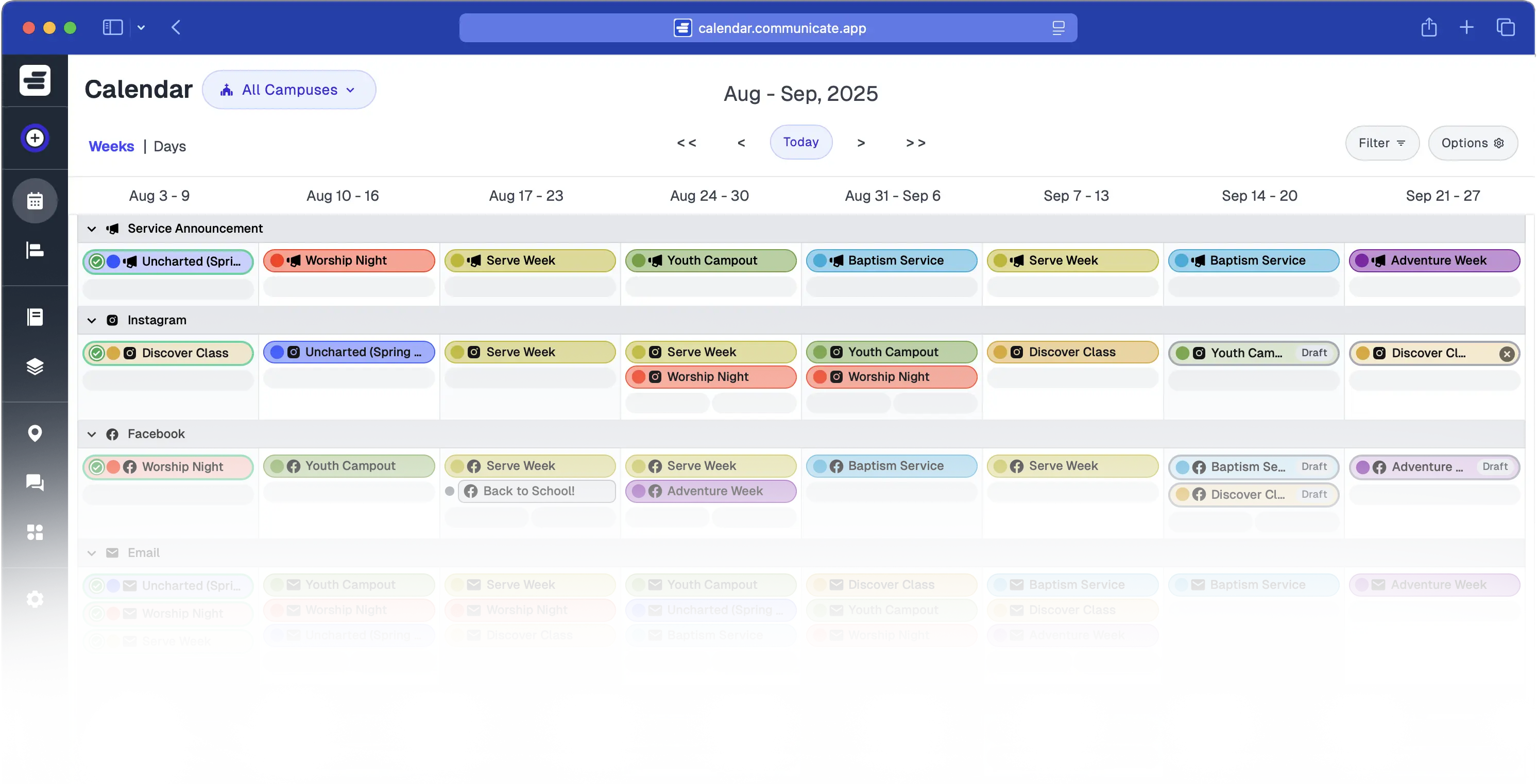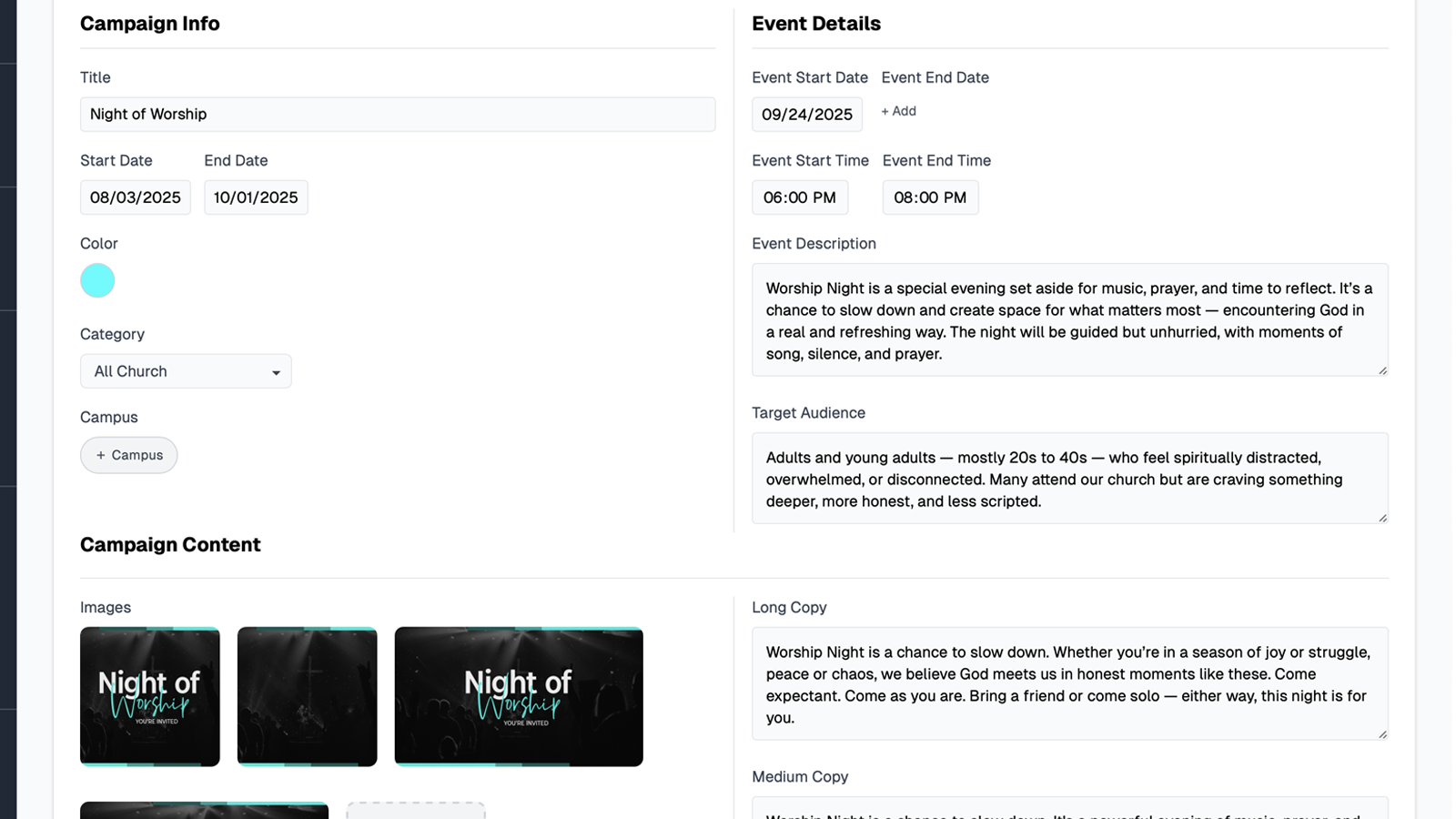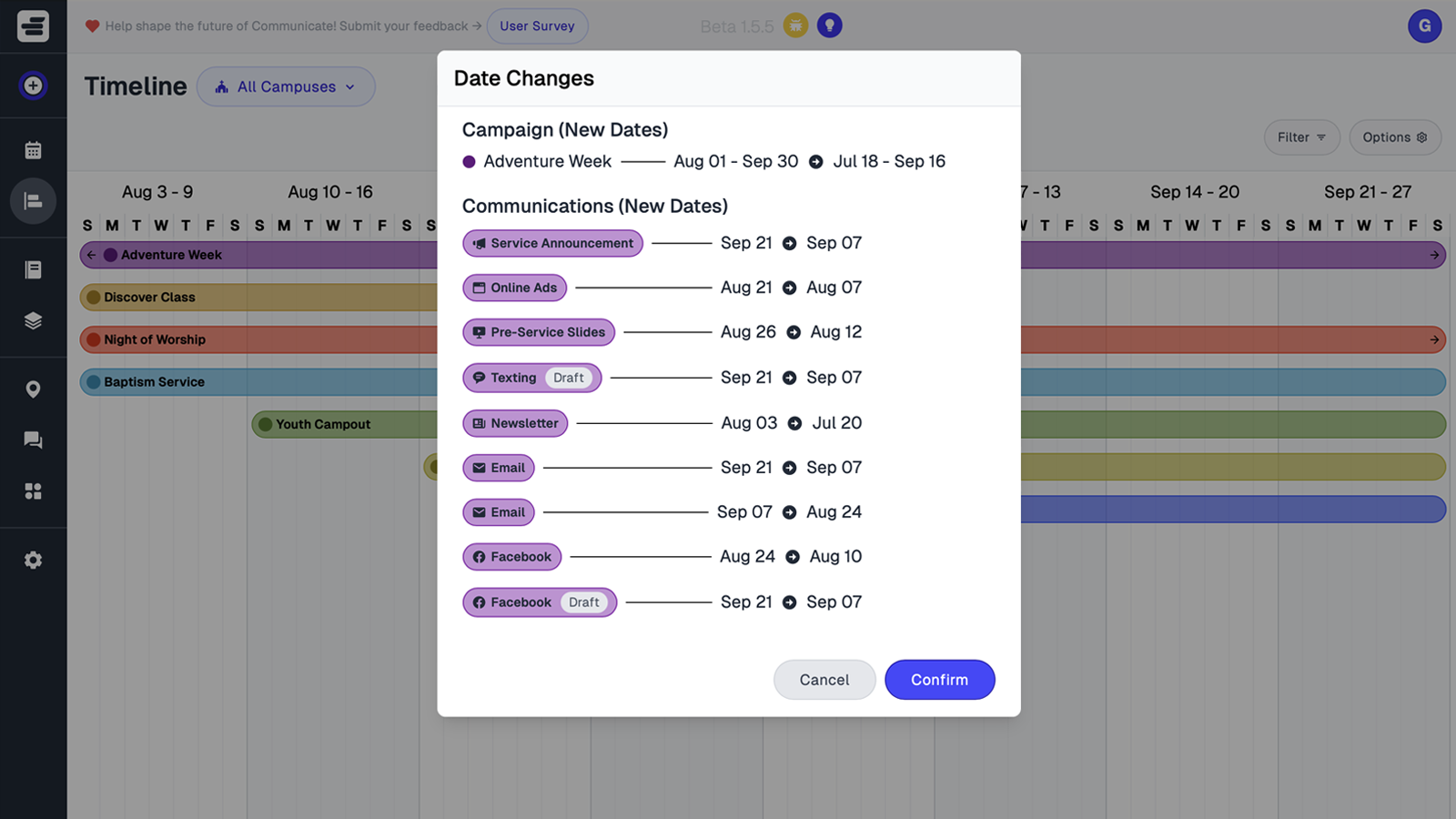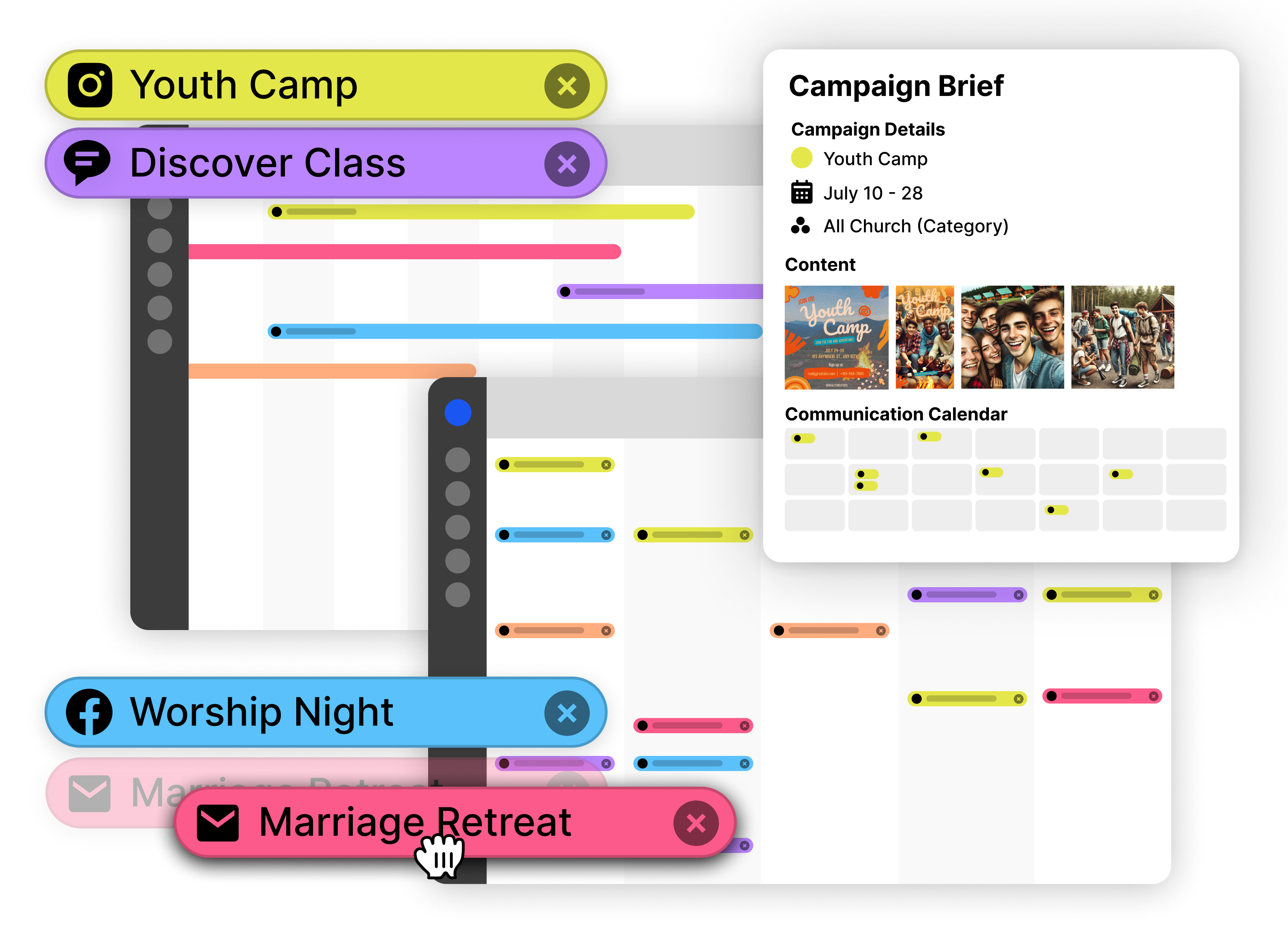A Smarter Church Communications Calendar
Say goodbye to scattered files and static spreadsheets.
Start Free Now

All your stuff. All in one place.
Build real messages—not just calendar events. Keep content, copy, and comments together so creative notes never get lost.
Map your entire month or tweak a single post in seconds, with quick edits and instant updates when plans change.
Group communications by event, ministry, or series, with clear owners and status updates to keep work moving.
Keep everyone aligned with campaign briefs, assignments, and context-rich comments so every voice stays in step.





Drag-and-Drop
Quickly move and reschedule content
Templates
Reusable formats for faster planning
Assignments
NewLet your team own their part
Filtering
Sort by channel, campaign, or type
Timeline
See everything at a glance
Campaign Brief
Shareable plan for your team
Multi-Site
Organize by location or audience
Notifications
NewNever lose track of your plan
Comments
NewKeep everyone on the same page
See how Communicate is helping church teams streamline their communications and stay organized.
"Our communications team has utilized this tool daily. It has become essential for our internal communication, managing the many moving pieces we oversee, and planning months in advance... we can't imagine working without it."
Alyssa
Christ Community Church | Laguna Hills, CA
"Communicate has helped us plan a lot better. We can focus on one plan at a time while still seeing how everything connects. It’s all in one place instead of searching through spreadsheets."
Andrew
Veritas Church | Cedar Rapids, IA
"Communicate has simplified our team's processes, allowing us to focus on making sure every message is effectively being shared. Such a helpful tool to make our communication more strategic and organized!""
Rachel
True Hope Church | Spokane, WA

Bring clarity to your message and confidence to your team. Start using Communicate free today.
Start Free NowSmart tools to save your team hours — and keep your church communications running smoothly.
Save hours every season by building reusable communication templates. Easter, VBS, Fall Kickoff — no need to rebuild the wheel. Just apply a pre-built schedule and watch your entire comms calendar populate in seconds. Adjust, personalize, and send — all in one place.

Stop digging through drives and emails. Communicate lets you store, tag, and reuse campaign assets like sermon copy, invite text, email headers, and social images. Write once. Repurpose everywhere. And keep your messaging consistent across every channel.

Church communications don’t happen in isolation. Our drag-and-drop Timeline View gives you a real-time overview of all your active campaigns—color-coded, adjustable, and crystal clear. Plan seasonally, spot gaps, and shift timelines without breaking a sweat.

Say goodbye to Slack threads and Sunday morning surprises. Communicate gives you a live look at every message in your church’s calendar — whether it’s in Draft, Active, or marked Done. Know what’s scheduled, what’s still in progress, and what’s already out the door. It’s like a traffic light for your communications — and your peace of mind.


End confusion and ensure everyone’s on the same page.
Eliminate messaging mix-ups across ministries. Communicate gives your staff a shared calendar view, lets them review content, and keeps all communications consistent across every channel and campaign.

Stay flexible, even when Sunday surprises you.
Ministry is dynamic — your calendar should be too. Shift campaign timelines with a click, adjust individual messages on the fly, or duplicate and tweak content as needed. With intuitive drag-and-drop tools, last-minute changes won’t throw your team off track.

Automate the busywork and focus on what matters most.
Reclaim your week with features designed to save you time. Use templates for repeat communications, duplicate entire campaigns in seconds, and adjust plans with drag-and-drop ease. With Communicate, your calendar works smarter—so you can, too.

Your content, campaigns, and team — all in sync.
Stop chasing down email threads, random docs, or outdated folders. Communicate brings every piece of your church’s communication—images, copy, content, and timelines—into one centralized hub. Stay focused, stay organized, and keep your messaging consistent across every channel.
Start using Communicate for free today.
Get Started FreeCommunicate is a communication calendar built specifically for churches. It’s designed for communication leaders, social media managers, and ministry teams who need to align messaging across email, text, social media, and more.
With drag-and-drop scheduling, customizable templates, campaign planning, and integrated communication channels, Communicate replaces spreadsheets and scattered tools with one organized platform.
Yes. Whether you’re managing a big event like Easter or a recurring series like youth nights, Communicate makes it easy to schedule content, assign it to campaigns, and keep everything aligned.
Campaigns are central planning containers for your communications. You set the timeframe, theme, and category, and then schedule all related communications inside that structure.
Channels represent where your messages go—such as email, Instagram, pre-service slides, or text. You can customize as many channels as you need and organize them by ministry or audience.
Yes. The calendar gives you a weekly or daily view of your communications across all channels. You can filter by campaign, channel, or category and make quick adjustments as needed.
Absolutely. Templates let you build out a repeatable communication plan and apply it to new campaigns in seconds. It’s perfect for events that follow a similar communication rhythm.
Yes. You can organize and schedule communications by location or audience, making it easy to manage messaging across campuses or ministries.
Yes, the platform is optimized for use across desktop, tablet, and mobile devices. Whether you’re in the office or on the go, your communications calendar is always accessible.
We’re actively developing integrations with third-party tools and expanding Communicate into a full church communications system, including tools for approval workflows, media libraries, and creative collaboration.